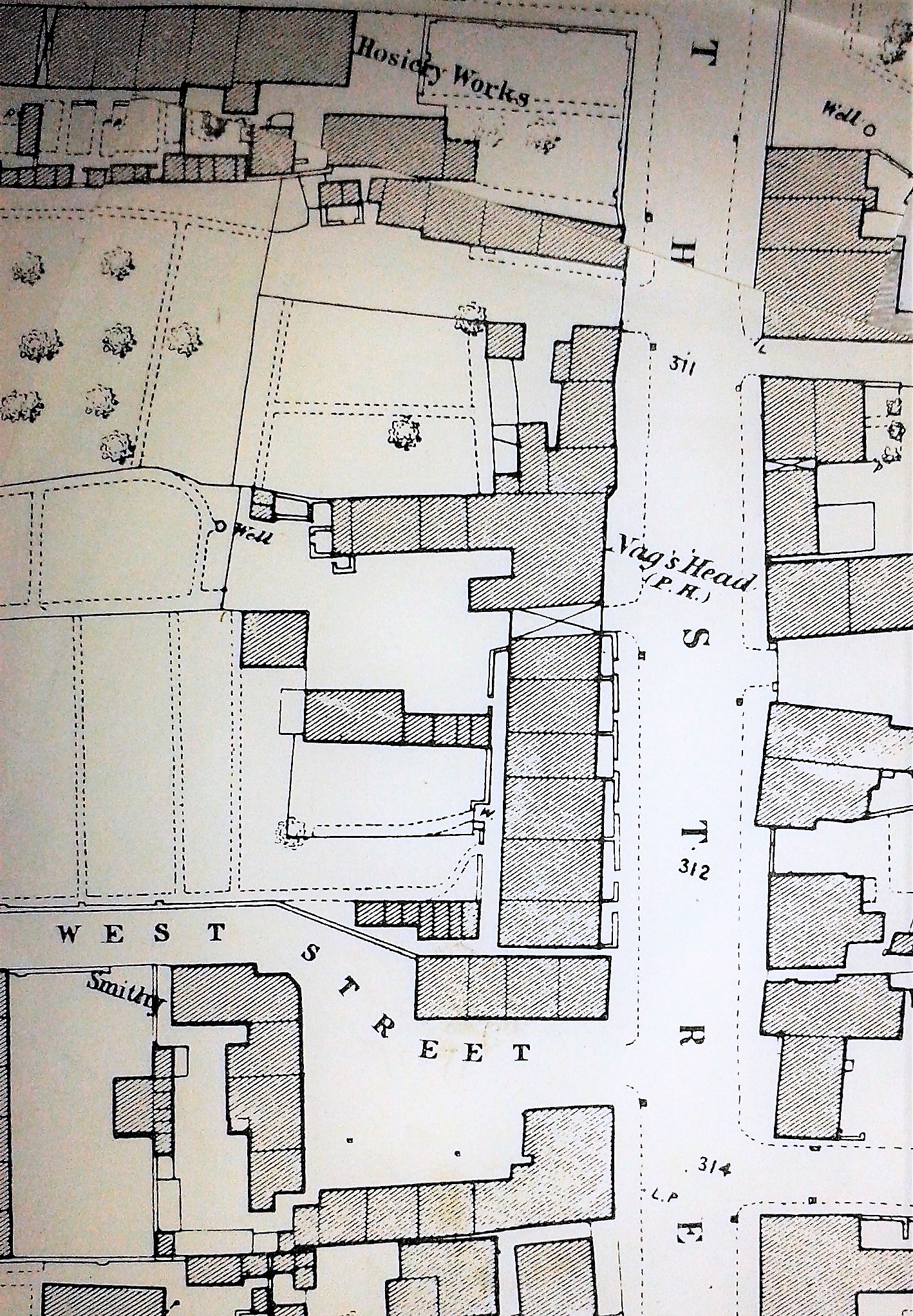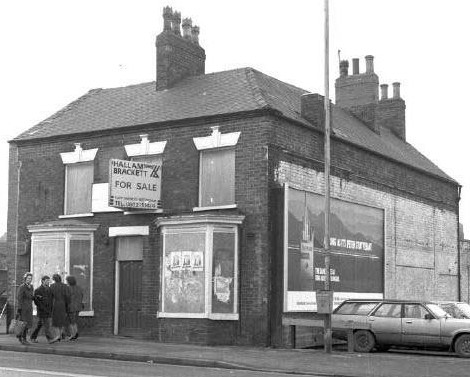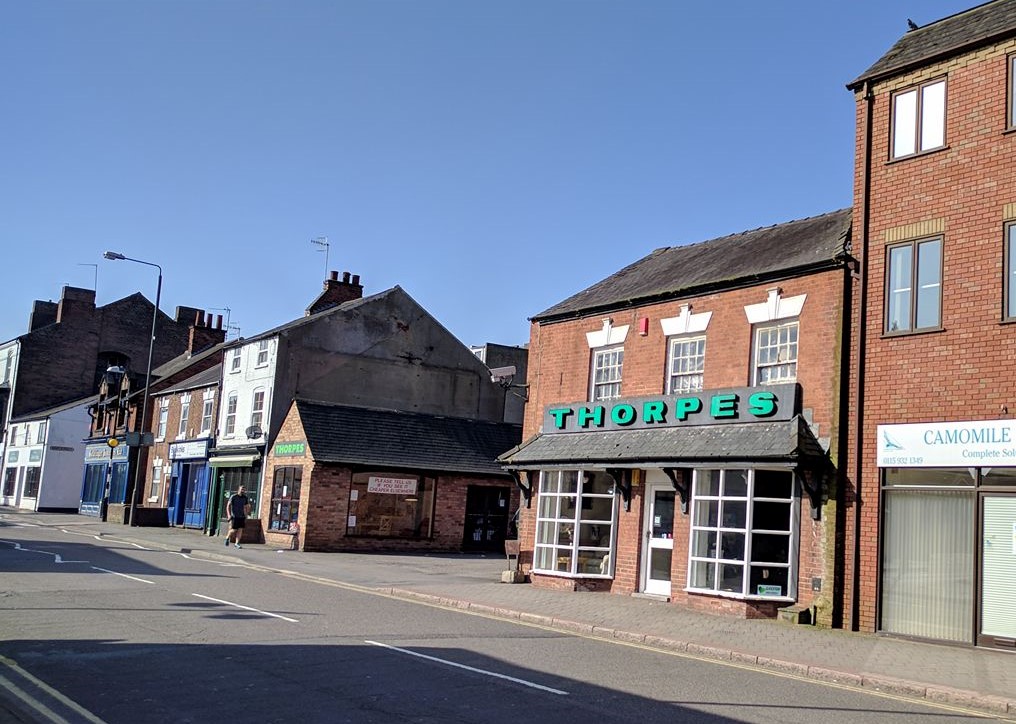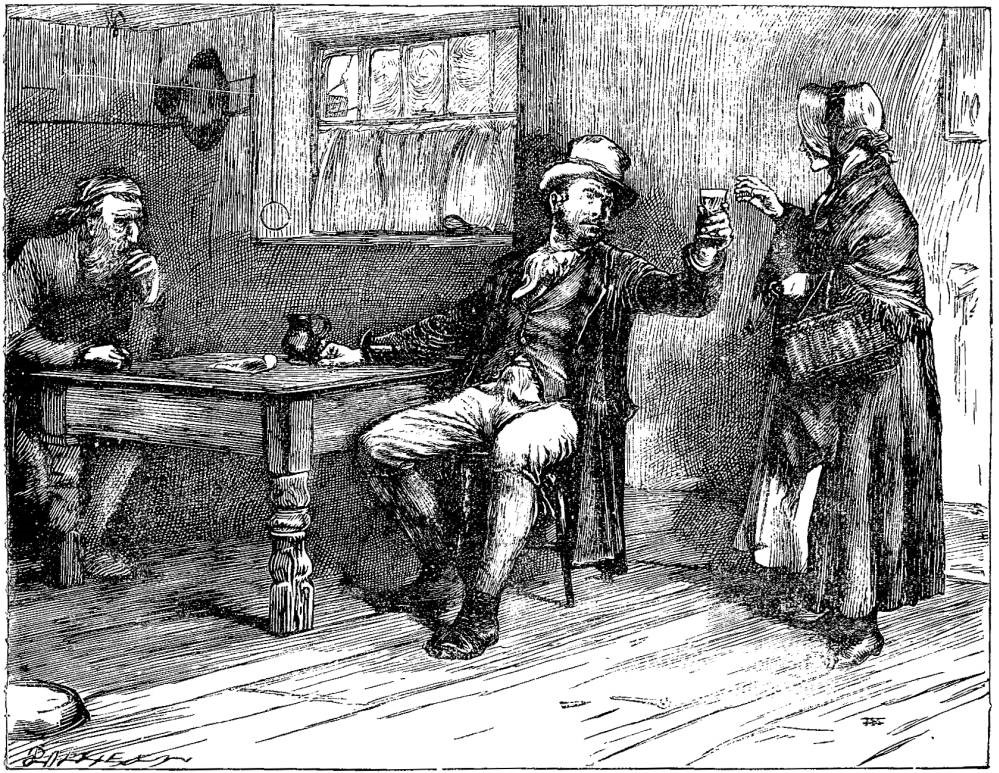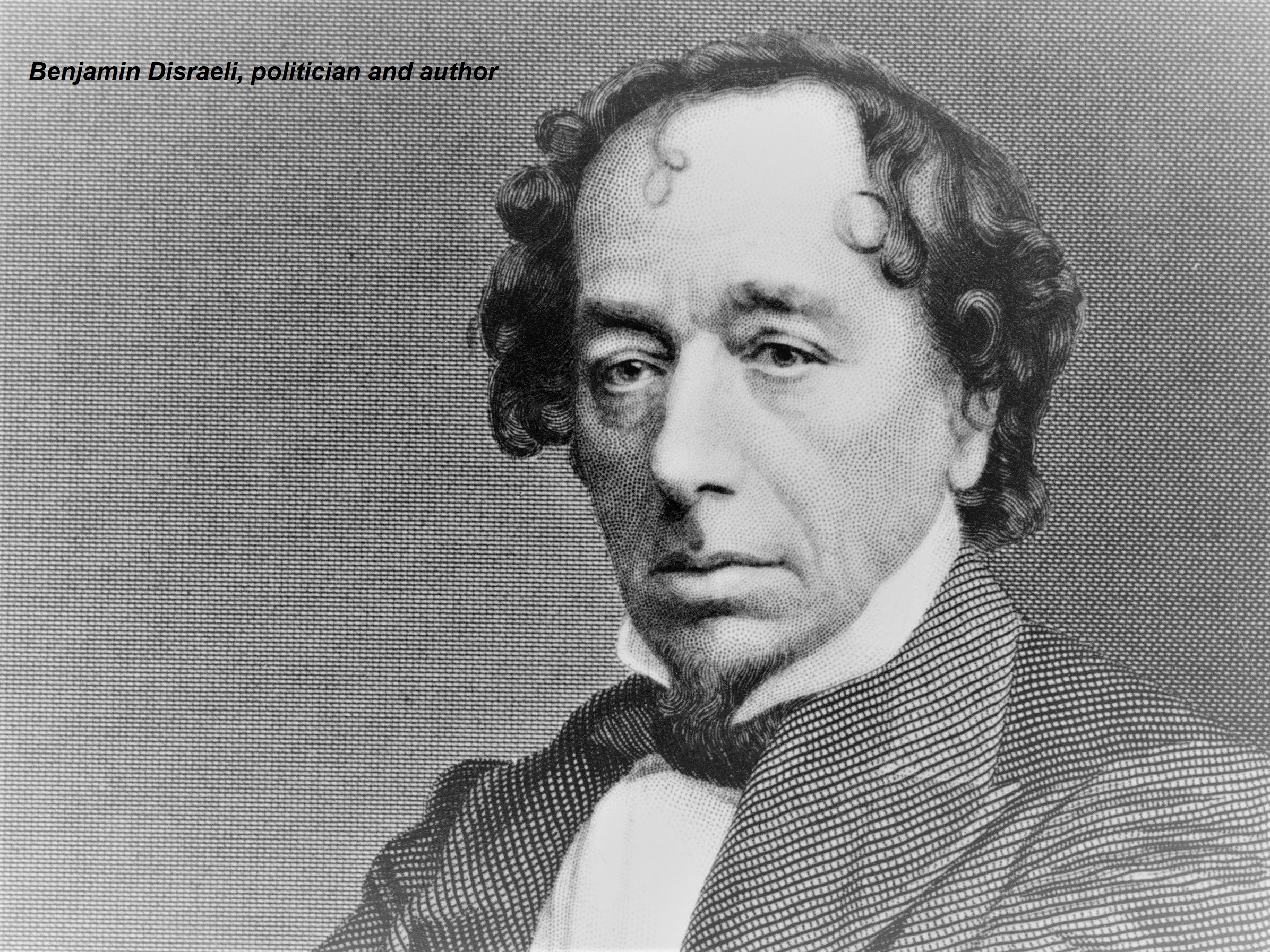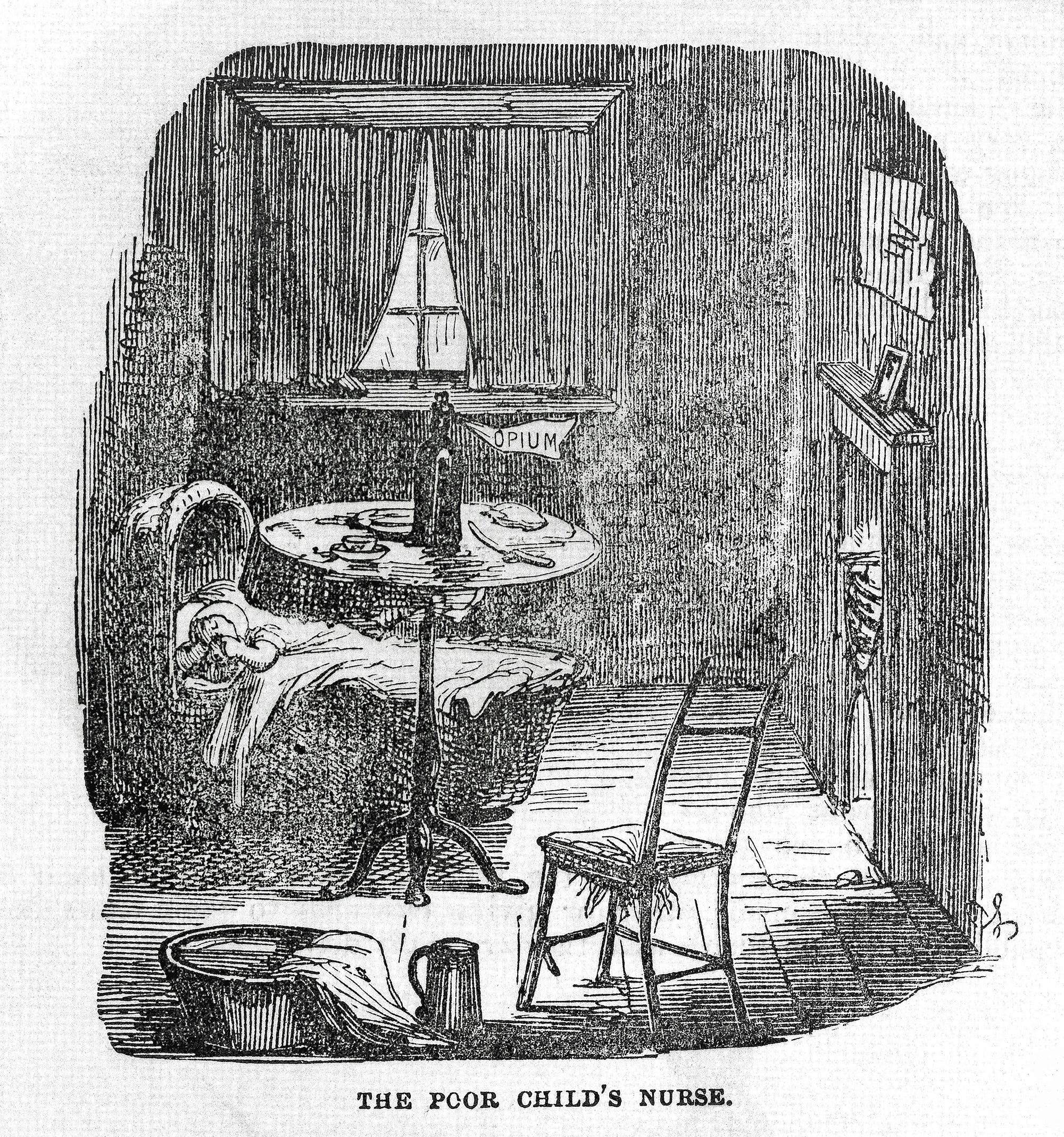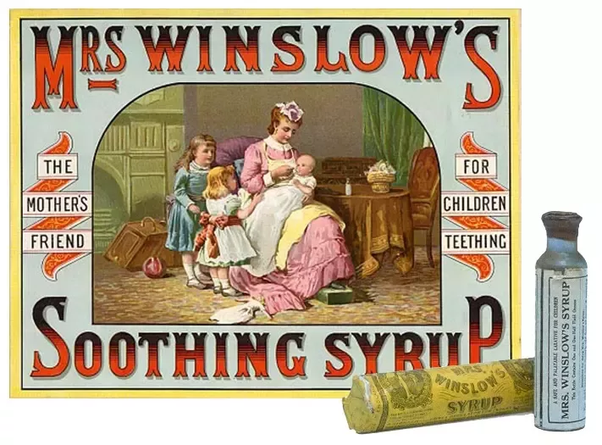After the old white house, we continue our walk along the west side of South Street, where Adeline points out that “next was the Nag’s Head”.
At the top of this map (left) you can just see Queen Street with the hosiery works of the Sudbury family.
And there, in the middle, is the Nag’s Head beerhouse.
Adeline recalls that “Mr. Knighton was the landlord of the Nag’s Head. He died in early life, and Mrs. Knighton carried on the business”.
This is at the site of Thorpe’s Toy and Furniture Shop “(2020).
In 1871 and 1881 this was 50/51 South Street, but after the renumbering of premises here in the late 1880s it became 38 South Street, and remained as such during the rest of the Victorian period.
Notice that there are features to help you recognise the same building in both photos … upper windows, position of the door and lower windows.
————————————————————————————————————————————–
The Landlords –and ladies — of the Nag’s Head beerhouse
Joseph Knighton (c1827-1864)
Joseph Knighton was the son of Samuel and Elizabeth (nee Boam), and the younger brother of …
… Godfrey who married Avice Blount on February 20th 1830, and went to live and work and raise a family in Eastwood.
… Cornelius who married Frances Mitchell on July 25th, 1831, and also left Ilkeston to work at Newthorpe Village in Nottinghamshire.
… Samuel junior who married Ann Mellor on June 25th 1839, his wife being the sister of several of the Mellors we have met or will meet shortly … like Hannah and John and William. After Ann’s death (December 26th, 1870) Samuel left to live in Leicester.
… Sarah who married Matthew Fletcher on April 17th 1842, and then lived at the General Havelock Inn in Stanton Road for many years.
… John who married Ann Duro on October 17th, 1837, and spent the last years of their lives keeping a grocer’s shop in Church Street, Cotmanhay.
… Mary who married James Hillen, a joiner, on December 24th 1837, lived in Basford and then Nottingham, where James died in 1852 and where Mary married her second husband, widower James Smith, also a joiner, on February 28th 1854. They lived in Bath Street and then Station Road where James died in October 1885. Mary then went to Beeston, Nottinghamshire, to live with her daughter Elizabeth Rachael who had married architect and surveyor George William Hawley of West Hallam. Mary’s other daughter, Sarah Hillen, married butcher William Tarlton of Bath Street.
… Elizabeth who married tailor Frederick Flint on July 15th, 1845.
In April 1848 Joseph Knighton married Sarah England, the oldest child of joiner William and Elizabeth (nee Waplington).
In the 1850’s Joseph was landlord of this beerhouse, and like many beerhouse keepers he fell foul of the law at times, when the Superintending Constable would visit such premises after hours. It was a condition of the licence that such drinking establishments closed their doors at 11pm, having made sure that all company had left. ‘Lock-ins’ were common however.
Joseph had a late visit from the Constable in July 1854, just as he had “forgotten” to ensure that all his customers had left the Nag’s Head by the required time. A previous offence of keeping a disorderly house seems to have counted against Joseph and he was fined heavily…£2 10s and 15s costs.
It wasn’t the last time that Joseph appeared in court for this offence.
And it wasn’t the only offence that he appeared in court for.
For example, in 1858 he was facing a charge of assault upon Mabel Webster and ‘her chap’, ironstone miner Henry Hughes. Joseph’s defence was that they were both very drunk when they entered the Nag’s Head and so had been refused further drink. Some choice language preceded the couple leaving the beerhouse, followed by Joseph, who was himself accused of being the worse for liquor. Their argument continued along South Street until the alleged assault took place. On hand was P.C. Butcher and it was probably his testimony against Joseph that led to the latter’s fine of 5s, with 8s expenses.
However no sooner had the parties left the justice room after the court case than cries were heard from outside. “Police, police, come and save my chap” cried Mabel as Joseph once more threatened Henry.
And immediately the beerhouse keeper found himself once more facing an assault charge.
And once more, a guilty verdict against him, another fine, more expenses, and this time Joseph was bound over to keep the peace for one year.
One month later, Mabel married ‘her chap’.
At this time beerhouses also had to comply with signage regulations. Such a house had to have a clear sign or notice over its door, with letters no less than three inches high in black paint on a white background, or white paint on a black background. Breaching these rules attracted a £10 fine.
In February 1859 Joseph was at it again. Perhaps the fact that he was entertaining ex-PC Smith at his establishment at 1 o’clock in the morning might have led him to think that he could get away with it ?? No such thing. P.c Bacon, on duty in South Street, had caught Smith at the Inn with a pint in front of him and wasn’t in a forgiving mood — despite the fact that Smith offered to buy him a drink !! Joseph’s brewer was also a member of the after-hours drinking party and swore at the subsequent Petty Sessions trial that he and Smith were total strangers to each other, and both had not touched a drop of ale at the Nag’s Head that night. The magistrates did not believe one word of what either man said !! And Joseph had to cough up for another hefty fine.
When would he learn his lesson ?
Joseph died from cirrhosis in August 1864, aged 37, only a short time after making another of his regular appearances in court.
Adeline “remembers three (Knighton) children” though there were, in fact, at least five children in the family.
1 … Sam who lived at the family home, trading as a joiner.
In April 1884 he married Hannah Evans of Trowell, second daughter of victualler/farmer Thomas and Mary (nee Allen). However in November 1885 and following in his father Joseph’s footsteps Samuel made an appearance at Ilkeston Petty Sessions, charged with abandoning his wife Hannah, leaving her destitute and supported by the Basford Union. He was ordered to pay 5s per week towards Hannah’s maintenance.
By 1891 Hannah was back at Trowell, living as housekeeper with her widowed mother while Samuel was at the Nag’s Head.
He died suddenly, at his mother’s home in Albert Street on January 2nd, 1901, aged 49, still separated from wife Hannah.
2 … Emma who also lived at home until she married on September 19th, 1876 to miner Frederick Lebeter. For a short time around 1891 he kept the Gladstone Inn in East Street.
3 … Sarah or Sarah Elizabeth who a few months before her younger sister’s marriage had married Robert Bentley of Purdy House Farm in Shipley — February 16th, 1876
Adeline correctly recalls these three children, but there was also their oldest child, William, born December 19th, 1848. He went to work at the Belper Union Workhouse, as a schoolmaster, and while there, married Annie Hollis on April 7th, 1874. In the late 1870’s thefamily moved to Sutton on the Forest in North Yorkshire and there William continued as a schoolmaster and later as a post master.
Surprisingly Adeline does not mention the youngest son George David. Born on April 28th, 1858 he continued to live with his mother until his marriage in 1892 to Mary Ann Louisa Blackburn, daughter of George and Louisa (nee Cope) of Kensington. At the end of the century he was still at the Nag’s Head Inn, 38 South Street.
It was George David who, in August 1896, picked ‘a fight’ with the Editor of the Sheffield Daily Telegraph who had been adjudicating a discussion on the proper use of the word “billion” and its meaning, within the pages of his newspaper. George David had strong views on this subject and wrote a letter to the editor, citing ‘Pendlebury’s Arithmatic’ and ‘Colenso’s Arithmatic’, in which letter he stated that a billion was a ‘million million’ …. thus contradicting the view of the editor (who believed taht a million millions was a trillion). In a footnote the latter replied that “the method by which a billion is reckoned as a million millions is unscientific and fast becoming antiquated”. I do believe that, at that time, George David had a strong case to regard his view as the correct one.
By this time, mother Sarah had retired into Albert Street where she died in July 1906, aged 80.
——————————————————————————————————————————————————————-
Charles Turton (1841-1883)
Adeline continues her Nag’s Head story …. “When Mrs. Woodruffe left the King’s Head, Mrs. Knighton with her family removed into the house. Mrs Knighton afterwards married Charles Turton, who lived in Pimlico”.
Five months after Joseph’s death his widow Sarah married labourer Charles Turton of Pimlico, son of John, lacemaker, and Hannah (nee Cordon) — and a younger brother of Sarah, who was soon to marry Thomas Tilson of Frank Hallam’s Row in Queen Street.
Although Charles had no children, he came from a rather large family, with at least 11 siblings. Most of these Turtons seem close-knit, at least geographically, many of them never wandering too far for too long, away from the Market Place and South Street areas.
Shortly after widow Sarah’s second marriage, the Turton couple moved to the King’s Head in the Market Place (about 1865) to replace William Woodruffe there. With them were Sarah’s children from her first marriage, except for son William.
As landlord of the King’s Head, Charles Turton had employed a young Henry Wilson as a general servant though it appears that the latter’s behaviour had caused the landlord to suspect his honesty.
In April 1874 he set a trap. He sent Henry down to Moor’s Bridge at the bottom of Derby Road to collect some hay from a stack there but at the same time asked the police to keep an eye of him. Which they did — in the form of Inspector Gray and P.C. William Colton. Their observations eventually revealed a missing bundle of hay. Henry had loaded the hay cart with one truss loose on top, had disappeared from sight for a minute or two, and then had reappeared, but minus the truss. He had done a deal with a local labourer who owned a cow and had left the bundle of hay in the lane for collection by his ‘client’.
Henry was charged with theft, pleaded guilty and spent the next two calendar months in jail, with hard labour.
Whilst at the King’s Head. Charles seems to have suffered from severe depression exacerbated by bouts of heavy drinking.
Early in 1876 he was found in the cellar of the inn, seriously wounded.
“During a fit of temporary mental derangement” he had attempted to commit suicide by cutting his throat with a pruning knife. The Ilkeston Telegraph reported that “his subsequent mental symptoms have been of a most distressing character, constant watch has to be kept over him and he lies in a precarious state”.
Charles did recover from his physical injuries but the watch on him was to prove ultimately unsuccessful.
In March 1879 the license of the Nag’s Head was transferred from Lucretia Duro to Charles Turton and so the Turtons now returned to the Nag’s Head – leaving Amos Boam as landlord at the King’s Head.
Charles’ depression crept up on him again in June 1883.
Once more he began drinking heavily – had he ever stopped? — and one Saturday he seemed very low and ill. His wife Sarah gave him a small beaten egg but he took only half of it. The doctor was consulted and relatives were brought in to watch over Charles.
The next day saw some improvement in his demeanour though he was still eating very little, and as the night approached Sarah noticed that Charles had gone upstairs. She rushed to follow him and found him, naked, standing at an open window, insisting that God had told him to jump out. and that ‘navvies are coming to chop us up’. He was persuaded to dress and brought downstairs where Sarah prepared some gruel with a little brandy in it.
On Monday morning, July 2nd 1883, Charles left the Nag’s Head at about six o’clock.
Before his departure he made a fire — unusual for him — and bid his servant man to ‘Be good to your missus‘.
Shortly thereafter he was seen close to the waterworks, at Sander’s orchard at the bottom of Queen Street, about 150 yards away from his home, by plumber and glazier Robert Burgin-Richardson who asked after his health. The landlord remarked that he had lately been feeling unwell but that he was now much improved and the two parted.
When Charles did not return for breakfast, the alarm was raised and a search conducted by the police and neighbours.
As he had been seen on Monday, walking by the side of the Nutbrook Canal, talking to himself ‘in a strange manner’, that waterway was partially drained the following morning and searched thoroughly but with no signs of the landlord.
In the afternoon a search of Sander’s orchard was instituted and Charles’s body was eventually discovered by gardener William Sanders junior amongst the gooseberry bushes growing in the orchard. He had cut his throat with a pruning knife.
‘The greatest commiseration is felt for his family in their sitress and the excitement in the town is such as scarcely been paralleled’. (IA 1883)
Almost immediately after Charles’s suicide, ’the police offering no objection’, the license of the Nag‘s Head was transferred to widow Sarah who continued as landlady until Otober 1892 when her son George David Knighton took over control. It remained in his hands at the close of the Victorian Age.
—————————————————————————————————————————————————–
William Duro (1814-1877)
“Mrs. Duro followed Mrs. Knighton as landlady of the Nag’s Head”.
While Charles and Sarah Turton were ‘mine hosts’ at the King’s Head, coalminer William Duro had moved into the Nag’s Head (about 1865). He was the only surviving son of labourer Richard and Mary (nee Beardsley) and had married Lucretia Rigley, illegitimate daughter of Mary, in April 1833, after which the couple had at least 11 children.
In 1870 a pint at the Nag’s Head cost tuppence ha’penny. (2½ old pence or 1p)
“Mrs Duro had two sons and three daughters. The eldest daughter married Mr. Albert Beardsley, baker, son of Mrs. Beardsley, draper, London House, Bath Street”. After six sons were born to William and Lucretia Duro — not all of them surviving — daughter Mary Ann was born in 1845 and it was she who married baker Albert Beardsley of London House in Bath Street.
Maria was at home. Mary Ann’s younger sister Maria married coal miner Richard Flint, son of George and Anne (nee Ford) in March 1869 and was widowed in April 1885 when her husband was crushed by a fall of coal at Oakwell Colliery.
Martha became a teacher at the Girls’ Church School. The youngest child Martha was a school teacher until she married Robert Augustus Hughes of the Royal Engineers in September 1880 and moved to Shropshire.
The eldest son and Ezekiel were miners. Of the boys in the family, the eldest, William, and John were coalminers as was Maria’s elder twin Ezekiel.
The one other surviving child, Grace, had at least four illegitimate children, (most of them?) with Joseph Baker, coalminer son of Joseph and Kezia (nee Fretwell) before marrying him in April 1872. She lived her married life at Fretwell’s Row.
In his novel ‘Sybil or the Two Nations’, published in 1845, Benjamin Disraeli wrote of life in a working-class area of a northern town. He criticised the popular use of laudanum, an opium-based painkiller, especially when given to fractious children to quieten them. As one character in the novel remarks,
“I should like to know what my mother ever did for me, but give me treacle and laudanum when I was a baby to stop my tongue and fill my stomach…”.
We move forward 21 years to the Duro household in South Street and spinster Grace had just given birth to her first child, William, in October 1866.
A week old, the child fell ill and it appears that Grace sent out for a halfpennyworth of laudanum to relieve its distress. She gave an empty gripe-water bottle to Martha Riley, aged 14, who took it along to the grocer’s shop of William Wright Turner in South Street. The grocer dispensed about 60 drops into the bottle but failed to attach a label. When the bottle was returned to Grace, she gave baby William about three drops of the laudanum which provided some temporary relief but this didn’t last.
Dr. Norman, who was then sent for, was very irate to learn of the drug’s use and prescribed his own course of treatment which sadly proved unsuccessful. William died soon after and the following day an inquest was held at the Nag’s Head where he had died.
The Coroner accepted that Grace had acted in the best interests of the child and seemed to be more critical of the behaviour of the supplying grocer, whose actions and subsequent testimony led the Coroner to suggest that Mr. Turner give up supplying laudanum — he was guilty of neglect in not putting a label on the bottle and needed to be much more careful in future.
The jury’s verdict was that the child’s death had been occasioned by laudanum unintentionally administered.
The drug would often be marketed under such euphemistic names as Mrs. Winslow’s Soothing Syrup, Dalby’s Elixir, and Godfrey’s Cordial (or ’The Quietness’) which contained opium, molasses, sassafras and spirits. It was the latter ‘medicine’ which, in December 1857, was administered to Samuel George Toplis, five-month-old son of John and Ruth Elizabeth (nee Youngman); the mother had given the cordial on several occasions to the infant, in the week before his death. Mr. Whiston, the inquest coroner, hoped this would be a warning to her for life, “and wished her to tell the mothers of other children who gave them cordial that it was nothing but poison, and never should be administered, unless by order of a medical man”. (IP). This warning doesn’t appear to have been passed on to Jane Henshaw (nee Fulwood), the mother of six-week-old John William Henshaw. Almost exactly one year later, her habitual and over-enthusiastic use of the drug caused the death of the baby, according to the jury of the subsequent inquest jury.
“The mother appeared to be perfectly ignorant of the nature of what she had given the child, and received an admonition as to her future treatment of children’. (DM)
A similar ‘treatment’ for pain relief and as a sleeping aid was poppy tea but this too could be lethal in excess, especially for infants. As for example 16 year-old embroiderer Harriet Pass of Burr Lane discovered when a dose of the tea was administered to her 18-day-old son in 1857.
And so it continued .. and continued. In August 1891 the Clarke family was living in Rutland Street where mother Elizabeth had just given birth to premature twins, Daniel and Thomas. Only six days old, weak and subject to convulsions from birth, they were both exhibiting signs of illness and couldn’t sleep. Elizabeth was in the habit of taking laudanum and suggested that a couple of drops would help the twins to sleep. Father John was reluctant but they reassured each other that a couple of diluted drops for each child would not harm them. Mixed with a little water, it seemed to solve one problem, but eventually another problem was evidenced — the babies wouldn’t stay awake and their breathing became laboured. Dr. Potter, who was called, suggested warm baths and to keep the twins awake, shaking them if necessary — easier said than done. And so when he came again the children had died. The fact that they were premature and not ‘fully formed‘ meant that the drug was too powerful for them, even in such a small dose.
The Derbyshire Times (August 29th) felt compelled to point out that “the adminsitration of laudanum to children is more largely indulged in than many would believe”.
And it wasn’t only babies and infants who succumbed to laudanum.
A few doors along from the Nag’s Head and just past West Street, Mrs Annie Elizabeth Kilburn kept lodgings, and in 1882, one of her ‘guests’ was Samuel Sanders, aged 73 yet still working hard as a general labourer. In February the cold and damp was getting to the old man, and he resorted to laudanum on a regular basis, to relieve his internal aches, pains and cold. He went out one night to buy a 2oz bottle of the drug and on his return to his ‘digs’ had already consumed half of his purchase. Although Samuel got up the next morning he was decidedly ‘worse for wear’. The doctor was called but when the latter arrived, his patient was already in a fit of apoplexy, accelerated — so the doctor said — by the laudanum which he had taken. And shortly after Samuel passed away.
——————————————————————————————————————————————-
In March 1877 William Duro died of cirrhosis of the liver at his South Street home.
The Will of William Duro
I have translated the will from ‘legalese’, a language adopted by lawyers to help justify their existence and further their business… and baffle the rest of us.
What is the point of using one simple word when half a dozen more obscure and complex words will serve the same purpose (and cause confusion)?!?
I hope that this translation will endeavour to facilitate one’s thorough comprehension of this legally executed document help you understand more easily.
This is the last Will and Testament of me, William Duro of Ilkeston in the County of Derby, Innkeeper.
I leave my three premises … 7, 8 and 9 Kensington … and any other of my land to my wife Lucretia while she lives.
After her death the first two properties — now occupied by Alice Sanders and Ann Trueman — are to go to my daughter Martha Duro and her heirs for ever, while the third property — now occupied by William Simpson — plus any other real estate are to go to my daughter Mary Ann, the wife of Albert Beardsley, and her heirs for ever.
After all my debts and expenses are paid I leave the remainder of my personal estate to my wife Lucretia, my daughter Martha and my friend Isaac Attenborough, Ilkeston victualler. My wife is to have the income from this estate, to continue the business if she wishes, and to use or sell any of the business capital as she wishes.
After Lucretia’s death any remaining estate will be divided equally between my six younger children … John Duro, Mary Ann Beardsley, Grace the wife of Joseph Baker, Ezekiel Duro, Maria the wife of Richard Flint, and Martha Duro.
The inheritance of any of my daughters who are married when they inherit shall be free from the control of their husbands*.
The executors of my will are my wife Lucretia, my daughter Martha and my friend Isaac Attenborough.
All former wills are invalid.
Signed, and dated August 8th 1874.
Witnessed by Charles Turton, victualler of Ilkeston,
and Frederick Flint, tailor and draper of Ilkeston.
William died on March 13th 1877 and the will was proved at Derby on June 4th 1877 by his widow.
The estate was under £200 in value.
*Before 1870 any money, income or inheritance which a woman had became the property of her husband when she married. Basically he could then do with it what he wanted. The woman became an extension of her husband.
1870 saw the beginning of the legal process to prise the man and woman apart. In that year the Married Women’s Property Act was passed, allowing any income earned by a married woman to remain her property.
A similar act of 1882 extended the rights of married women to grant them the same rights over property as unmarried women.
In May 1877 the Nag’s Head licence was transferred to William’s widow, Lucretia and as we have seen was transferred to Charles Turton in March 1879.
The Colliers’ Cemetery
While William Duro was the only surviving son of Richard and Mary, he had several living sisters. One of these was Elizabeth, born in 1805, who married Cotmanhay coalminer Samuel Webster on May 28th, 1826.
It was in 1858, about ten years after Samuel and Elizabeth had ‘completed‘ their family of ten children, that these Websters were implicated in a serious scandel at their home in the depths of Cotmanhay, a scandel which astounded and outraged the Ilkeston Pioneer. And many others !!
One of their daughters was Harriet, born on November 6th 1834. It was in November of 1858 that she and her parents received a visit from John Hudson, Ilkeston’s Superintendent of Police, after he had learned that the daughter had, a few days before, given birth to an illegitimate child, had concealed the birth, and then had ‘improperly disposed‘ of the baby. He interviewed Harriet, her mother Elizabeth and her sisters Eliza, Elizabeth and Grace, and all initially denied any charges against them. It was when he threatened to send for Dr Norman to conduct an examination that they made several admissions, and the mother then showed the Superintendent where a small body was buried in their garden, about three feet down. This was Harriet’s child, but buried with it was the recent miscarriage (after four months pregnancy) of daughter Eliza.
The body of the baby was then taken to Dr. Norman whose examination revealed it was probably a still-birth, after about eight months pregnancy, though the doctor couldn’t determine whether it was the result of an induced abortion.
Neighbours of the Websters told of how Harriet admitted her pregnancy, had vowed not to get married, but instead ‘get rid’ of the baby. And of how Eliza had miscarried at about the same time.
All of this was revealed at the inquest into the death of Harriet’s child a few days later when the Websters were once more interviewed, though their evidence was adjudged to be evasive and contradictory; both the Coronor and the inquest jury ‘expressed themselves unwilling to give the slightest credence to their testimony‘. The Coronor also commented upon the ‘open, deep and unblushing depravity‘ of the family. However it was also revealed that they were not an isolated case; there were several Cotmanhay families whose daughters ‘regularly destroy or conceal the fruits of their illicit intercourse, and inter them in gardens around their dwellings, which have now acquired the unenviable title of “The Colliers’ Cemetery”‘.
However the evidence of Dr. Norman was sufficently inconclusive as to elicit just a severe reprimand from the Coronor; he could do no more than issue ‘strong comments’ and then to free Harriet.
This, however, didn’t stop the Pioneer feeling obliged to pass judgement, despite the fact that much of the evidence was hidden from its readers as it was thought unfit for publication. ‘The revelations made at the inquest were astounding, even to those who have long and painfully observed the habits of debauchery and wickedness which are known to exist in many of the stinking nooks and rookeries of the parish”
Several of the daughters in this Webster family seemed to have had an aversion to marriage but a proclivity for giving birth to children. At the time of the ‘scandel’ the Webster parents were living with their daughter Eliza and her three illegitimate sons, Amos, Isaiah and John; a further illegitimate son, George, was born in 1860 but died in infancy. Only on November 30th, 1861 did Eliza marry collier George Limb and then have at least another six children. She died in 1903.
Also in the Webster household was daughter Elizabeth whose first registered illegitimate child, Angelina, was born in 1860. And at least four more followed.
After the scandel, daughter Harriet had, by 1866, ‘befriended’ widower Joseph Riggett Carr (himself illegitimate ?) and had five children with him (all births this time registered !! … as Webster). It was only in 1889 that she married Joseph, and died two years later.
A younger daughter, Grace, born in 1837, had only one illegitimate child — Elizabeth Sheldon Webster — in 1863, before marrying the child’s father, James Sheldon, in 1864.
The family was indeed a very tangled web.
————————————————————————————————————————————————-
William Wright Turner.
A few months after the death of William Duro — posthumously — he was to share a similarity with the man criticised for his part in the death of the publican’s grandson… that is the child of Grace Duro.
William Wright Turner was born in Colne, Lancashire in 1828, the son of cotton warper Robert and Rachel (nee Wright).
In January 1852 he married Nottingham-born Eliza Killingley in her home city and shortly thereafter the couple moved to Ilkeston, for a time living in Regent Street, when William worked as a shopman for grocer William Marshall (of the same street).
Now this is where you will have to concentrate!!
William’s older brother was James Turner who married Ann Bussey at St. Mary’s Church, Ilkeston on March 15th 1850. She was a daughter of cork cutter James and Matilda (nee Dance) of Nottingham.
Her mother Matilda, daughter of Isaac and Ann (nee Key), had an older sister Maria who had married grocer William Marshall at Derby in October 1818.
A simple connection between employer and employee!!
William Wright Turner later moved into South Street to trade as a grocer and there his wife Eliza died on June 8th 1866, aged 39. By that time and after 14 years of marriage she had given birth to (at least) ten children.
A few months later, at Queen Street Baptist Chapel, William Turner married widow Eliza Chadburn (nee Kirk) and then moved to work in Nottingham.
And ten years after the death of Grace Duro’s infant from laudanum poisoning, William Turner had a shop in Woodborough Road in the city, still trading as a grocer and chemist. In that shop, one Thursday afternoon in October 1877, William lapsed into a coma and died. A post mortem found evidence of a brain haemorrhage while the heart was also enlarged and the liver was “in that state which is found in habitual drunkards”.
Death was therefore caused by “apoplexy brought on by excessive drinking”.
———————————————————————————————————————————————————-
Accident Alert !! Saturday Jun 2nd 1866
At about five minutes to eleven at night, Philip Huskinson was leaving the Nag’s Head with fellow colliers John Bostock and Samuel Trueman when he saw John starting to light up a cigar.
Philip asked his pal if he had another one that he could have .. “Come on, John: I will run you for two cigars“.
John agreed to the race.
There was nothing more that some Ilkestonians liked than a bet and a contest !!
Samuel trotted off ahead, to the Toll Bar, to make sure that nothing was coming.
All was clear and so the two ‘athletes‘ set off at a leisurely pace. Almost immediately they both collided with a cart belonging to John Robey which was standing at the roadside. Down they both went !! Samuel hadn’t seen it — it hadn’t been there a couple of minutes ago !!
John Bostock got up and was able to walk away, while Philip was taken to his father-in-law’s house in Baptist Chapel Yard, feeling distinctly unwell — the father-in-law was boatman William Henson and Philip had married his daughter, Caroline, in 1863.
Doctor William Date was sent for but, as he wasn’t at home, his assistant attended the injured collier. However Dr Date attended to him the next morning and at once suspected serious injuries … Phillip was now very weak and in great pain. He died the following Monday morning.
At the inquest the next day, Dr. Date declared that death was caused by rupture of the stomach or upper portion of the bowels, or both.
How come two ‘careless’ colliers could run into a parked cart ?!! A review of Ilkeston’s street lighting in the 1850’s/60’s might provide a partial answer.
After less than three years of marriage, Caroline Huskinson was now a widow with a son, Albert, born in 1863. She remained a widow until she married collier Thomas Brewin on Christmas Day 1873.
—————————————————————————————————————————————————————
And just past the Nag’s Head, a row of houses which you can see in the map at the top.

